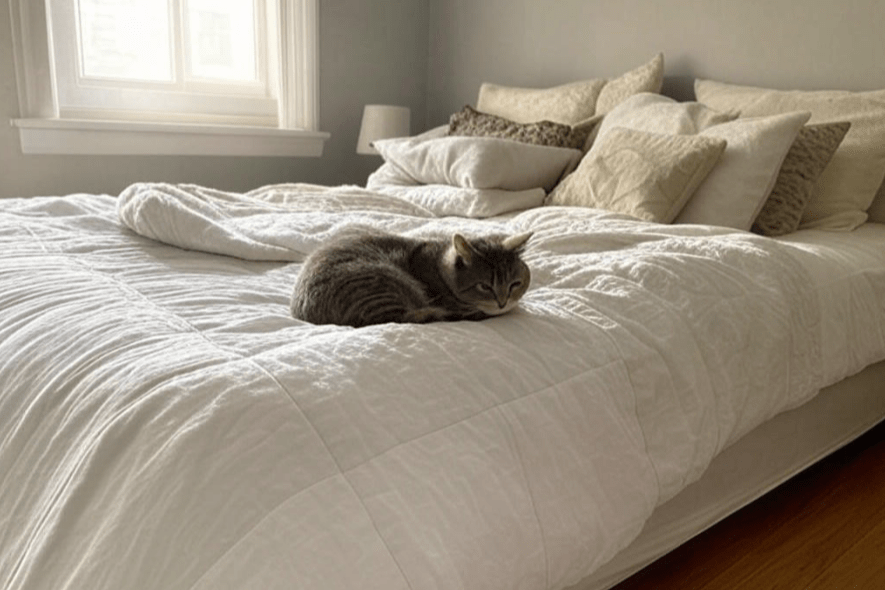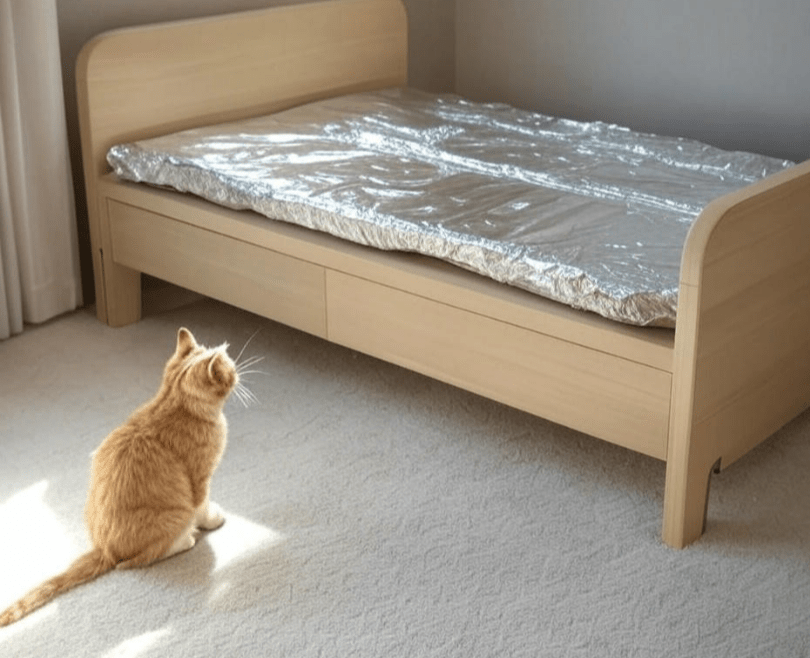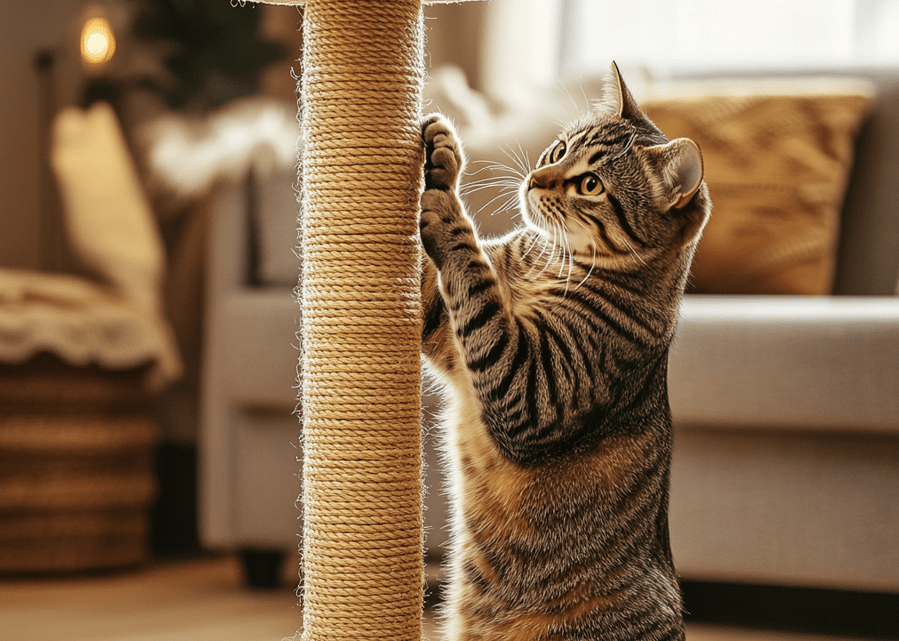
There’s nothing quite like snuggling into bed after a long day—until your feline friend decides it’s their bed too. From midnight zoomies to fur-covered sheets, sharing your sleep space with a cat can disrupt rest and leave you sneezing. If you’ve ever wondered how to train a cat to stay off the bed, you’re not alone. While cats are independent creatures, they can learn new boundaries with patience and the right techniques.
In this guide, we’ll explore why cats love beds, effective training methods, and alternative sleeping solutions to keep both you and your pet happy. Whether your cat is a persistent cuddler or a stealthy bed invader, you’ll find actionable strategies to reclaim your sleep sanctuary—without sacrificing your bond.
Why Cats Love Your Bed (And How to Change Their Mind)
Cats are naturally drawn to soft, warm, and elevated spaces—qualities that perfectly describe your bed. Their instinct tells them that high spots offer safety, while your scent provides comfort. Unfortunately, this makes your mattress irresistible. Understanding why your cat insists on sleeping with you is the first step in redirecting their behavior.
Some cats seek warmth, others crave companionship, and a few simply enjoy the vantage point to monitor their territory. If allergies, disrupted sleep, or hygiene concerns are motivating your decision to keep them off, rest assured—there are humane ways to discourage the habit while ensuring your cat still feels secure.
Step-by-Step Guide: How to Train a Cat to Stay Off the Bed
Training a cat to stay off the bed requires a thoughtful approach that balances deterrence with positive reinforcement. Unlike dogs, cats are independent and less motivated by obedience, so forcing them off the bed through scolding or punishment will only lead to stress and resistance. Instead, the key is to make the bed an unappealing place while simultaneously providing a more attractive alternative. Below, we’ll explore a detailed, step-by-step method to help your feline friend learn where they should sleep—without damaging your bond.
1. Make the Bed an Undesirable Territory
Cats are selective about where they rest, preferring warm, soft, and secure spots. To discourage them from claiming your bed, you’ll need to disrupt its appeal—temporarily.

Aluminum Foil or Plastic Mats: Many cats dislike the crinkly texture of foil or the slippery feel of plastic. Spread sheets of aluminum foil or a plastic office mat over the bed when you’re not using it. The unfamiliar sensation will make them think twice before jumping up.
Double-Sided Sticky Tape: Apply strips of pet-safe sticky tape along the edges of the bed. Cats hate the feeling of sticky paws and will quickly learn to avoid the area.
Unpleasant (But Safe) Scents: A light spritz of citrus-scented spray or diluted essential oils (like lemon or orange) can deter them. Cats have sensitive noses, and strong citrus smells are naturally off-putting to them.
Change the Bedding Texture: If your cat loves plush blankets, switch to a tightly woven, smoother fabric for a while. A less cozy surface may reduce their interest.
These methods work best when used consistently for at least a week or two. Over time, your cat will associate the bed with discomfort rather than comfort.
2. Create an Irresistible Alternative Sleeping Spot
Simply telling a cat not to sleep somewhere isn’t enough—you must give them a better option. Cats seek out sleeping spots for warmth, security, and elevation, so their new bed should check all these boxes.
Choose the Right Cat Bed: Look for one with high sides or a hood for a sense of security. Memory foam or self-warming beds are excellent for comfort.

Place It Strategically: Position the bed near a sunny window, a radiator, or in a quiet corner where your cat already likes to nap. If they enjoy being near you, place it beside your bed at first, then gradually move it farther away.
Add Familiar Scents: Rub a soft cloth on your cat’s cheeks (where their scent glands are) and then wipe it on their new bed. This makes it smell like their space.
Use Warmth as a Draw: A microwavable heat pad or a low-voltage heated pet bed can make their spot even more enticing than yours.
3. Reward and Reinforce Good Behavior
Positive reinforcement is the most effective way to train a cat. Punishment can lead to fear or defiance, but rewards build good habits.

Treats and Praise: Whenever you see your cat using their own bed, immediately reward them with a small treat and verbal praise (“Good job!”). This reinforces the idea that their bed is a happy place.
Clicker Training (Optional): If your cat responds well to clicker training, use a clicker the moment they settle into their bed, followed by a treat. This creates a strong mental association between the behavior and the reward.
Interactive Play Near Their Bed: Engage your cat in play sessions near their designated sleeping area. After tiring them out with a feather wand or laser pointer, they’ll be more likely to curl up in their own space.
4. Establish a Nighttime Routine
Cats are creatures of habit, and a predictable routine helps them adjust to new rules.
Play Before Bed: A 10-15 minute play session before bedtime burns off energy and makes them more likely to sleep soundly—in their own space.
Feeding Schedule: Offer a small meal or treat in their bed right before you go to sleep. A full belly encourages relaxation.
Gradual Distance Adjustment: If your cat is used to sleeping right next to you, start by placing their bed beside yours, then slowly move it farther away over several nights.
5. Be Patient and Consistent
Cats don’t change habits overnight. Some may adjust within days, while others take weeks. The most important factors are:
No Mixed Signals: If you occasionally let them on the bed “just this once,” they’ll keep trying. Everyone in the household must enforce the same rule.
Persistence Pays Off: If your cat tests the boundaries (and they will), calmly return them to their own bed without frustration. Over time, they’ll get the message.
What If My Cat Still Won’t Stay Off? Troubleshooting Tips
If your cat still refuses to stay off the bed, consider these additional strategies:
Motion-Activated Deterrents: Devices like the Ssscat spray (which releases a harmless puff of air when triggered) can startle them away without your direct involvement.
Temporary Bedroom Restrictions: If all else fails, keep the bedroom door closed at night for a few weeks. This breaks the habit completely, after which you can reintroduce access—with their own bed as the only option.
Automatic Feeders or Toys at Night: Distract them with activities away from the bed.
Check for Anxiety: Some cats seek the bed for security. If your cat seems unusually clingy, consult a vet or feline behaviorist to rule out stress or health issues.
Keeping Your Sleep Space Fur-Free (Even If They Sneak In)

Even with the best training efforts, some determined felines will still occasionally sneak onto the bed—whether for a midnight cuddle or simply because they can’t resist the comfort. To minimize fur buildup and maintain a clean sleep environment, consider implementing a multi-layered defense strategy. Start by placing a washable throw blanket over your comforter; this acts as a sacrificial layer that can be easily removed and laundered when covered in fur. Regular grooming is essential—brushing your cat several times a week with a deshedding tool significantly reduces loose hair before it ever reaches your sheets. For allergy sufferers or those particularly sensitive to fur, an air purifier with a HEPA filter near the bed can capture airborne dander, while a handheld vacuum or lint roller kept bedside allows for quick cleanups. If your cat does manage to settle in despite your efforts, keep a designated “cat towel” nearby to gently relocate them without a struggle, reinforcing the habit of returning to their own space. By combining these practical measures with consistent training, you’ll drastically cut down on fur while still accommodating the occasional feline trespasser.
Final Thoughts
Learning how to train a cat to stay off the bed takes time, but the payoff—a clean, undisturbed sleep—is worth it. By understanding your cat’s instincts and using positive reinforcement, you can create a harmonious living space where both of you rest easy.
Remember, every cat is different. Some may adjust quickly, while others need extra patience. Stay consistent, reward good behavior, and soon, your bed will be yours again—fur-free and fully comfortable.




